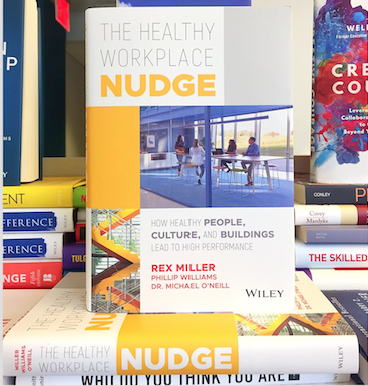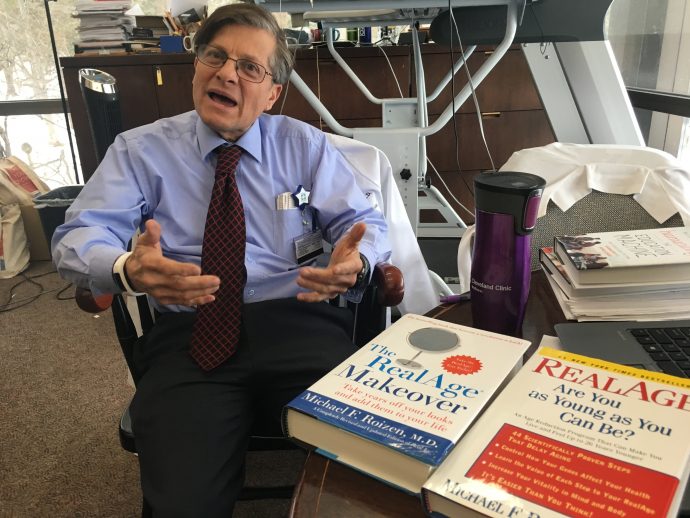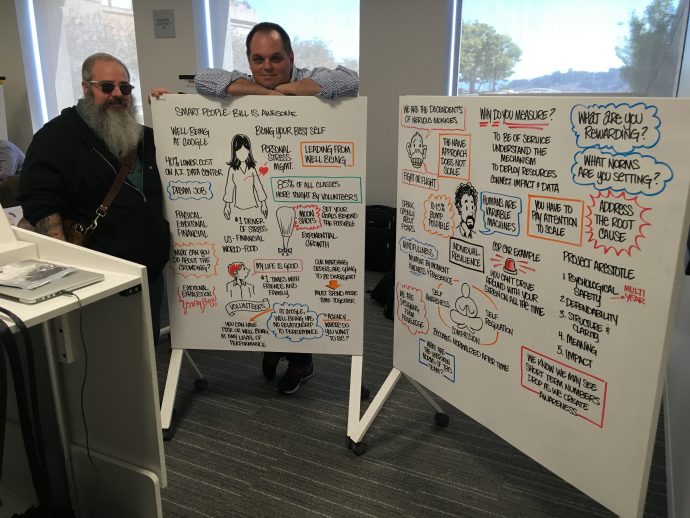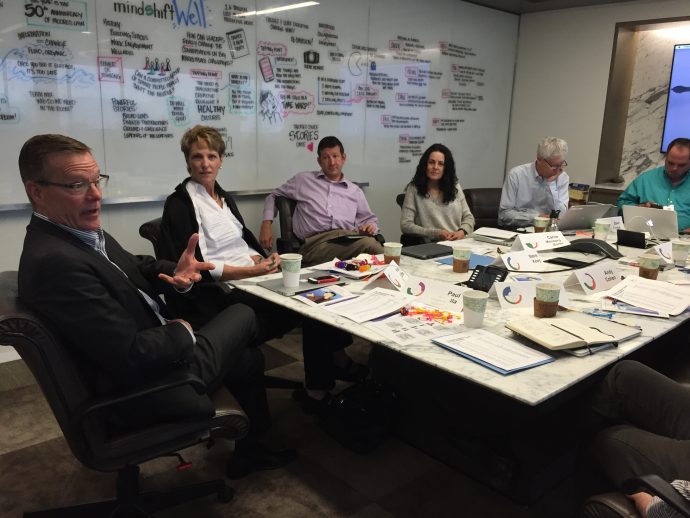As Rex Miller prepared for the release of his latest book, “The Healthy Workplace Nudge”, WDM spoke with him to get the inside scoop on the inspiration and motivation behind the story.

Where did the idea for this book come from?
The inspiration for this book grew from a previous project, “Change Your Space, Change Your Culture.” That book presented the CBRE headquarters project in LA. Needing a new building, they looked at different business models and visited offices around the world. Our story presented their excellent change management process.
More than that, however, they demonstrated full engagement – with their employees, their past, their present, and their future. Lew Horne, the President of CBRE’s Southern California and Hawaii Division, pulled the workforce into a new consideration of the future. It’s a compelling story on how design changed corporate culture. The story also revealed the difference between push solutions – the experts solving it – and pull solutions – when you galvanize people with vision, open their horizons, and go out and solve the problem together.
Soon after the book came out, we started getting a great response. And, much of it seemed to revolve around CBRE. Lew’s office kept ordering cases of the book over the next year. I finally asked him what was going on. He told me that because of the book, over 14,000 people had come to visit their space in the previous eighteen months. As we talked, he also mentioned that the wellness side of their renovation had been making huge improvements to morale, work habits, and even positively affecting employee home life.
I flew to Los Angeles; I had to see it for myself.
In my meeting with Lew, I saw another story, an even better one. CBRE was the very first corporate WELL certified building. That was in 2013. And, it was the first time that building science and medical science came together to create a measurably healthy environment – and provide a framework and guidelines for others to do the same. To me, that was the “aha” moment. I saw that was also the first time that a built environment became the major “character” in the story of wellness.
So, in the summer of 2015, I collected a group of 12 leaders including Paul Scialla and Phil Williams from Delos, Mabel Casey from Haworth, Andy Cohen from Gensler, two long-time lead architects for Google, Kate Lister, and a few others. After our tour of CBRE, we understood CBRE’s transformation and why it created such an overwhelming response. But, the tour also raised concerns that our industry might be jumping aboard the wellness train without really understanding what creates employee wellness.
In January 2016, we assembled a larger team of industry voices and experts in Chicago. We had to bring others into the conversation. By the end of that two-day gathering, I saw the energy, interest, and commitment were launching a new MindShift project around wellness.

We eventually gathered more than 130 leaders and specialists. And, for 18 months, we traveled, observed, and collaborated around research at the Cleveland Clinic, the Mayo Clinic, Kaiser Permanente, Vanderbilt Children’s Hospital, Texas A&M’s Center for Health Systems & Design, RAND Health Advisory Services, and many others.
Most of our innovative work emerged during a series of eight summits hosted by organizations, including Google and GoDaddy, which were making groundbreaking progress. It was an invigorating journey for all of us and extremely eye-opening as we connected the dots.

I explain in the book how our original assumptions got shredded by the evidence. That drove us to start over. The first time I hit the shredder was during my first meeting with Dr. Michael Roizen, the Chief Wellness Officer for the Cleveland Clinic. When he described, in such graphic detail, the true burning platform, I saw an existential threat to every business and our national economy. Section one of our book, The Slow-Moving Storm, will and should scare the hell out of readers. That looming threat could very well rip our social fabric apart.
Can you give us some more background on the burning platform?
Dr. Roizen explained how the rise of chronic disease would double our health costs in the next ten years. Double – 36 percent of GDP. I flew home shaken by that meeting.
He gave me copies of his data and visuals. When I shared them with our team, we all wondered why that information isn’t the number one concern for every company in America!

After that point, our research took on a completely new dimension. The stakes were so much higher than just finding ways to do wellness better. Our work turned into investigative reporting.
That soon led to three characters who were like Michael Burry, a central figure in the book and movie, The Big Short. Burry, a hedge fund investor with Asperger’s, had this capacity to make sense of massive amounts of data and not be swayed by the established or official narrative. When he saw the numbers, he knew the whole real estate industry was a house of cards. Many, including his investors, thought he had lost touch with reality.
But, what he knew, and we discovered, is that math is reality.
So, these three wellness industry icons, more accurately iconoclasts, are brilliant and irrefutable curators of the numbers. And, they are also no longer invited to wellness conferences. They include Al Lewis, the father of disease management who later repudiated his own work when the data could not support the conclusions. Al introduced me to Tom Emerick, the former head of benefits for Walmart, BP and Burger King. He is also an actuary; he knows the numbers. Tom then introduced me to Soeren Mattke, the author of the Rand report. That was the congressionally-mandated research study on the effectiveness of wellness programs, done as a pillar of the Affordable Care Act.
When you look at the research and the math, 95 percent of wellness programs do not work. Lewis, Emerick, Mattke, and a growing chorus of other leaders say the programs are a waste of money. We also learned that the average cost of $700 per employee per year on wellness programs is a fraction of the full expense when you add administration costs, false positive health assessments, time off for programs and follow-up, loss of productivity, etc.
Meanwhile, the wellness industry mantra claims that a dollar spent on wellness programs produces anywhere from $3-$9 in return. I started digging to find the source of that idea. What was the research behind it? You know what? It doesn’t exist. The closest you will get is a Harvard study that was later retracted. But, it has been repeated so many times that, like many other legends, it is simply assumed to be true.
So, why do over 90 percent of companies still rely on wellness programs?
Too many leaders are just not engaged in their company’s wellness needs or programs. They can’t; they’re too busy. So they hand it off to HR, who hands it off to vendors. That should work; after all, aren’t they the experts? The truth is most vendor programs just add new features, incentives, or programs every year or two, but they are not improving health and health outcomes. They don’t even deal with the employees; they see HR as their customer. Furthermore, most companies are just trusting that the wellness vendors know what they are doing. But, very few companies have specialists on staff who know how to question them or have the time or resources to dig beneath the numbers.
So, what is the answer to employee wellness?
The real payload of the book exposes that we are still operating with old and obsolete models for explaining and influencing human behavior. That’s why the wellness industry’s strong narrative of getting people to take more steps, eat better, lose weight, stop smoking, etc. doesn’t work.

Instead, we found that creating a healthy building is something any company can do for as little as the cost of supplying coffee to your employees for one year. It delivers passive health benefits to 100 percent of your employees 100 percent of the time. The International WELL Building Standard provides a design guide and opportunity to achieve certification of a measurably healthier environment. Lew Horne said that he receives a thank you weekly from employees who love working in their space. DPR completed their Reston, VA offices and Chris Gorthy showed me how they were able to achieve WELL certification for less than one percent of a cost increase over their original design. Their offices are worth touring and they are in your backyard.
The second low-cost high-payoff practice comes from the emerging field of behavioral economics better explains human decision making. The idea that small design nudges in the environment shift behavior represent a real breakthrough in how to improve wellness. Most surprising perhaps is that the cost for that approach is so much less expensive than the typical wellness process.
This book is a roadmap into that new territory. We also tell many stories about companies that are doing great jobs with their own wellness strategies. We also have a section about how to lead change in your company if you’re not in a decision-making role. And, we also present how to recalculate ROI when it comes to health strategies.
You mentioned that only five percent of companies are capable of implementing a real wellness program. What are the characteristics of that?
First, companies need to look at health outcome goals, not participation. They also need discipline and rigor, decision-making metrics, and effective incentives. The Cleveland Clinic offers $2,400 to each employee annually for achieving what they call “five normals” in cholesterol, triglycerides, blood pressure, Body Mass Index, and cotinine (a measure of smoking). So simple. No complicated or expensive programs. Just five little numbers.

Phil Williams – President of Business Development for Delos; Kate Lister – President of Global Workplace Analytics; Steve Koy – Former Head of Sustainability for Haworth; Carrie Meinburg-Burke – Principal for Parabola Design; Dave Pogue – Global Director of Corporate Responsibility for CBRE; Michael Lagocki – Graphic Facilitator and Event Designer for MindShift.
Now that you’ve been through all this, where do you think this is going to go in the future?
Here’s a secret: Well-being is a larger issue than wellness. That is THE driver for good health. If you’re in an environment of high stress, it doesn’t matter how many steps you take or how many meditation classes you attend. That stress is literally killing you. We are beginning the conversation about how the workplace can help reinforce different behaviors and habits, just like we did in “Change Your Space, Change Your Culture.” But, this time around it’s focused on health and well-being. The process of broad participation that Lew Horne created for CBRE’s project sparked an ongoing conversation about how they wanted to work and live together. We observed in the previous book that space was a proxy for culture. What we meant is that space, good or bad, reflected what the organization valued. Naturally, that manifested in how people behaved and worked together, good or bad. Because of that, architects and designers can facilitate new conversations with new tools. Building science and medical science are now linked like never before.
You can now see that the conversation about wellness is far more than having workout space and serving healthier vending machine food. It also means having quiet areas, places to focus and do more concentrated work, making information easy to access, and taking the friction out of the workplace. It gives you a whole different kind of metric to evaluate effectiveness in workplace performance.
Do you see corporate America embracing this?
I don’t think they have a choice. Health costs will drive them to look for alternatives. Companies that figure this out the fastest will have a huge competitive advantage over their peers. And, that is the real story and the real value of The Healthy Workplace Nudge.
“The Healthy Workplace Nudge: How Healthy People, Culture, and Buildings Lead to High Performance” is now available to purchase on Amazon.
All images in this article were courtesy of Rex Miller.


